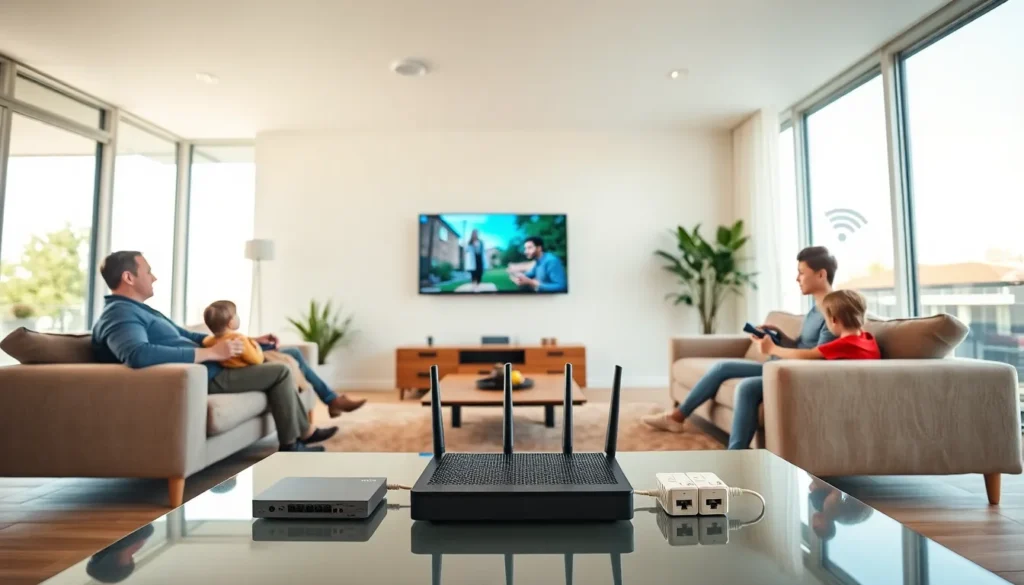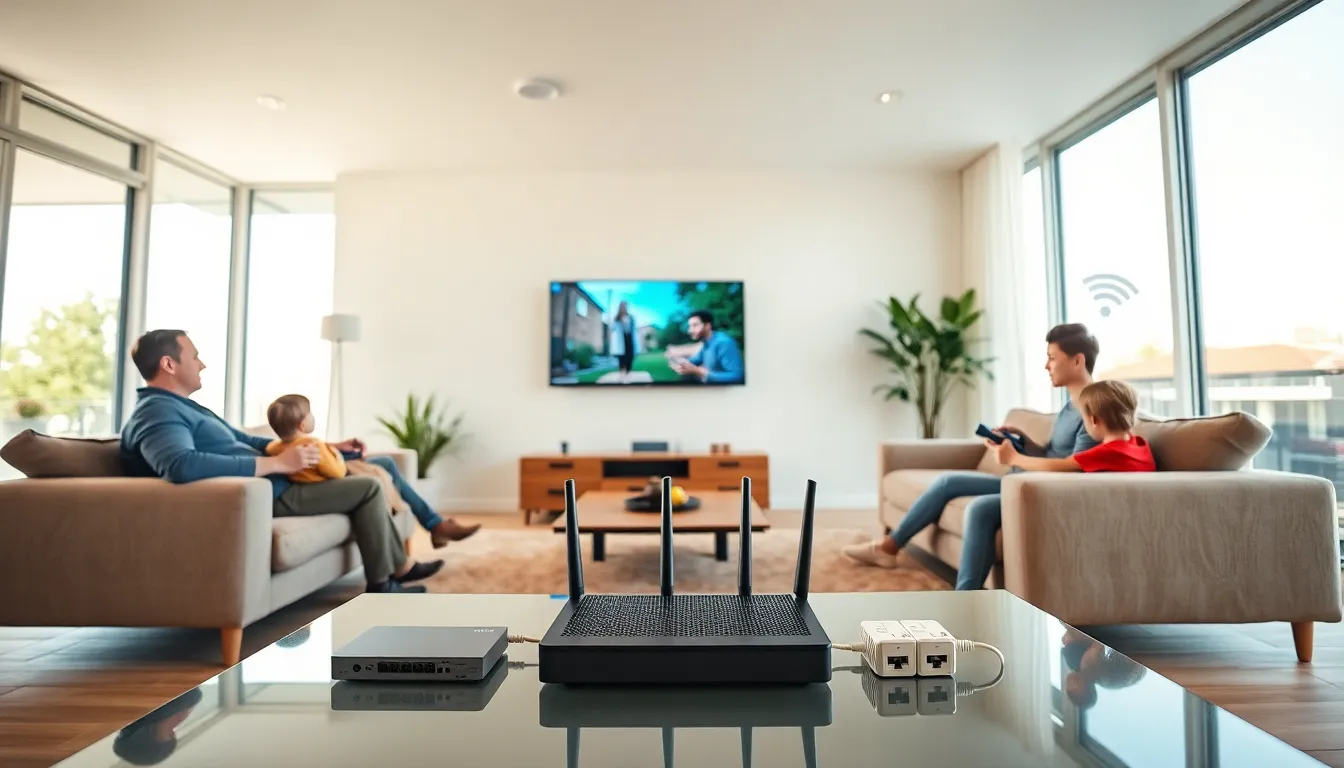Imagine streaming your favorite series in one room while your kids game in another, all without buffering. That’s the magic of effective home networking solutions. In today’s digital age, a robust home network isn’t just a luxury: it’s a necessity. But navigating the tech landscape can feel like trying to solve a Rubik’s Cube blindfolded. Fear not. This guide breaks down everything you need to know about creating a reliable home network, without pulling your hair out. Let’s immerse.
Table of Contents
ToggleUnderstanding Home Networks

A home network is like the central nervous system of your technological ecosystem. At its core, it connects various devices within the home, allowing them to communicate with each other and access the internet. Think of it as a web: your laptops, smartphones, smart TVs, and even your security cameras, all intertwined in a harmonious dance of data.
Many homes today use a blend of wired and wireless connections. Wired connections, through Ethernet cables, provide a stable and speedy connection, ideal for gaming or video streaming. On the other hand, wireless connections offer convenience and flexibility, letting you roam freely, albeit sometimes with a reduction in speed. Understanding these basics sets the foundation for choosing the best solutions for your home.
Types of Home Networking Solutions
There are various networking solutions available, each catering to different needs:
- Wired Networks: Using Ethernet cables for connection, wired setups are often the most reliable, offering faster speeds and lower latency. They are perfect for streaming or gaming enthusiasts.
- Wireless Networks: Typically based on Wi-Fi technology, these networks provide the convenience of mobility. While easy to set up, performance can fluctuate based on distance from the router and interference from walls or electronic devices.
- Mesh Networks: This innovative structure utilizes multiple nodes placed throughout your home. They create a unified network that minimizes dead zones, ensuring seamless connectivity in larger spaces.
- Powerline Adapters: For homes where running cables isn’t an option, powerline adapters can use existing electrical wiring to transmit internet signals, providing a wired-like performance without extensive cabling.
Choosing between these solutions depends on your home layout, internet usage needs, and budget.
Choosing the Right Hardware
Selecting the right hardware is crucial for an effective home network. Here’s a quick checklist to guide your purchasing decisions:
- Router: This is the heart of your network. Look for routers that support the latest Wi-Fi standards (like Wi-Fi 6), which offer improved speed and capacity. Consider features like dual-band or tri-band capabilities for better performance.
- Modem: If your internet service is via a cable provider, you’ll need a modem. Some ISPs offer modem-router combos. But, standalone modems often provide better performance.
- Range Extenders and Mesh Systems: If your home has dead zones, consider adding a range extender or investing in a mesh network for extensive coverage. These devices help eliminate weak signal areas, giving you a stronger connection throughout your home.
- Network Switches: If you have multiple wired devices, a network switch can expand your wired connections without sacrificing speed.
Setting Up Your Home Network
Setting up a home network can be straightforward when you follow these steps:
- Positioning: Place your router in a central location to maximize coverage. Higher placements often yield better results, as signals travel downwards better than upwards.
- Wiring: If using wired connections, run Ethernet cables from the router to various rooms as needed.
- Configuring the Router: Using a computer or mobile device, access the router settings through a browser. Change the default password, establish a solid Wi-Fi encryption (like WPA3), and set a unique network name.
- Connecting Devices: Begin connecting your devices, both wired and wireless. Ensure that all smart devices, like smart TVs or thermostats, are connected to the proper network.
- Testing Connections: Once everything is set up, conduct speed tests in various areas to ensure the network is performing as expected. Adjust positioning and settings if necessary.
Security Considerations for Home Networks
In today’s world, a secure home network is vital to protect personal data and privacy. Here are essential security practices:
- Change Default Logins: Many routers come with default usernames and passwords. Change these immediately to something unique to prevent unauthorized access.
- Use Strong Encryption: Always enable WPA3 encryption to safeguard your Wi-Fi from potential intrusions.
- Regular Updates: Keep your router’s firmware updated. Manufacturers regularly release updates to patch vulnerabilities.
- Guest Networks: For visitors, set up a separate guest network. This boundaries excess access and keeps your main network secure.
- Monitoring Devices: Regularly check connected devices through the router’s admin panel. Spotting unfamiliar devices can help prevent unauthorized access.
Troubleshooting Common Issues
Even the best networks can experience hiccups. Here’s how to tackle common issues:
- Slow Speeds: If things seem sluggish, first check how many devices are connected. Too many can drain bandwidth. Restarting the router can also clear up temporary issues.
- Dropped Connections: Device distance from the router can impact stability. If interruptions occur, try repositioning the router or using range extenders to boost the signal.
- Interference: Other electronics or networks can interfere with Wi-Fi signals. Changing the channel of your router can help alleviate congestion.
- Network Limitations: Finally, check if your internet plan offers sufficient bandwidth for your needs. Sometimes it may be necessary to upgrade your plan.
Future Trends in Home Networking
As technology continues to evolve, so do home networking solutions. Here’s what the future might hold:
- Wi-Fi 7: The next generation of Wi-Fi promises even faster speeds and better efficiency, paving the way for smoother video streaming and gaming experiences.
- Smart Home Integration: Expect tighter integration with smart home devices, allowing networks to self-manage and optimize based on usage patterns.
- AI-Driven Networks: The future may see artificial intelligence helping in managing home networks, predicting connectivity issues, and automatically fixing them before they become a problem.
- Advanced Security Solutions: As threats become more sophisticated, expect networks to integrate advanced security solutions to guard against hacking and breaches.





